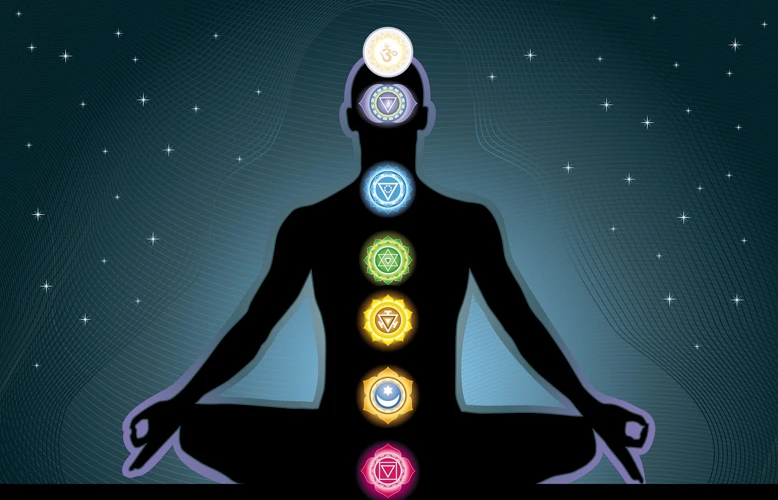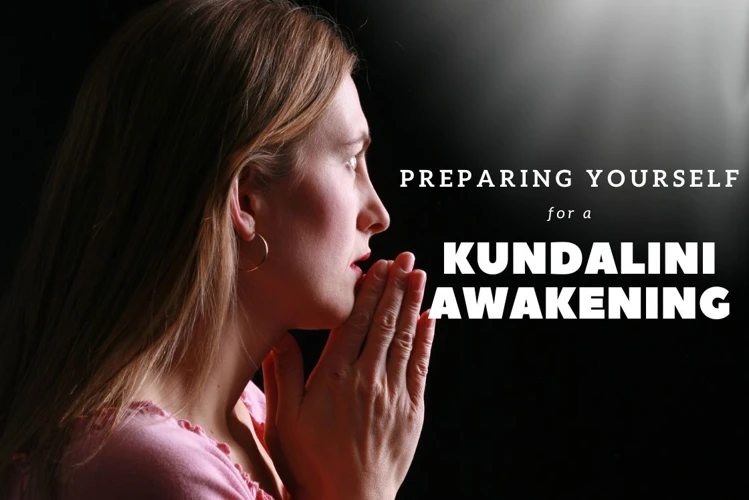As individuals journey through their spiritual evolution, they may experience a phenomenon known as Kundalini awakening. This process can be both exhilarating and challenging, as various physical, emotional and psychological symptoms can arise. While the experience is unique to each person, meditation has been noted as a potent tool to help ease symptoms and navigate this journey. In this article, we will explore the role of meditation in easing Kundalini awakening symptoms, the types of meditation that can support this process, as well as other practices that can help enhance one’s Kundalini awakening journey.
Understanding Kundalini Awakening

Kundalini awakening is a complex process that often leaves individuals feeling confused and overwhelmed by the sudden changes they are experiencing. The awakening is believed to occur when the dormant energy lying at the base of the spine is activated and starts to ascend through the chakras. This can result in a range of physical, emotional, and psychological symptoms that can be difficult to manage without the proper tools and guidance. Understanding this enigmatic process is critical to finding ways to ease symptoms and embrace the potential benefits of Kundalini awakening. In the following sections, we will explore the concept of Kundalini awakening and the symptoms associated with it.
What is Kundalini awakening?
Kundalini awakening is a spiritual process that involves the awakening of a dormant energy that resides at the base of the spine. This energy is represented by a coiled serpent, and is believed to be a powerful source of spiritual energy that can help individuals attain higher levels of consciousness and spiritual awareness.
The process of Kundalini awakening is a deeply transformative experience that has been described as both powerful and challenging. During Kundalini awakening, the dormant energy at the base of the spine becomes activated and begins to move upwards towards the crown of the head. This process is often associated with a range of physical, emotional, and spiritual symptoms, including intense sensations of heat, vibration, and pressure; feelings of bliss, euphoria, and spiritual ecstasy; as well as periods of confusion, fear, and intense emotional release.
Despite its challenges, Kundalini awakening is often seen as a deeply transformative and life-changing experience. It can be a powerful catalyst for spiritual growth, helping individuals to release old patterns and beliefs, and enabling them to connect more deeply with their true selves and the divine. However, it is important to approach Kundalini awakening with respect and caution, as it can also be a destabilising experience that requires support and guidance from experienced practitioners.
Kundalini awakening is a powerful spiritual process that has the potential to transform and deepen an individual’s relationship with themselves and the world around them.
Symptoms of Kundalini Awakening
When experiencing Kundalini awakening, individuals may notice a wide variety of symptoms, which can be both physical and mental. Some of the symptoms include:
- Body sensations: Individuals may feel a range of sensations, including tingling, vibrating, heat or cold flashes, or electric-like shocks.
- Emotional highs and lows: There may be an increase in emotional sensitivity or extreme mood swings, ranging from joy and elation to fear and anxiety.
- Changes in sleeping patterns: Some individuals may experience insomnia or difficulty falling asleep, while others may sleep more than usual.
- Intense dreams or nightmares: Vivid and intense dreams or nightmares may occur, which can be symbolic or prophetic in nature.
- Physical symptoms: Physical sensations may include pain, headaches, digestive issues, or changes in appetite.
- Heightened intuition: As the Kundalini energy moves through the body, individuals may experience heightened intuition or psychic abilities.
- Spiritual experiences: Some individuals may experience a connection to a higher power or a sense of unity with all things.
It’s important to note that every individual’s experience with Kundalini awakening will be unique and may not include all of these symptoms. It’s also important to seek the guidance of a trained professional, as some of these symptoms can be intense and may require support to manage.
The Role of Meditation in Easing Kundalini Awakening Symptoms

If you’re experiencing Kundalini awakening symptoms, meditation can be a powerful tool to help ease the intensity of these experiences. By cultivating a regular meditation practice, you can learn to manage and harness the energy of Kundalini, facilitating a smoother and more grounded spiritual journey. In this section, we’ll explore the role of meditation in easing Kundalini awakening symptoms and delve into different types of meditation practices that can be beneficial for this process.
How Meditation Helps with Kundalini Awakening Symptoms
Meditation is an incredibly powerful tool that can help ease the symptoms of Kundalini awakening. Here are some of the ways meditation can help:
- Reduces stress: Meditation can help reduce the stress that often accompanies Kundalini awakening. When your body and mind are in a relaxed state, it can help ease the physical symptoms of awakening, such as tremors and vibrations.
- Increases self-awareness: Kundalini awakening can bring up intense emotions and thoughts. Meditation can help increase self-awareness and allow you to observe these thoughts and feelings without getting caught up in them. This can help you deal with them in a healthier way.
- Improves focus and concentration: As Kundalini energy moves through your body, it can be difficult to remain focused and grounded. Meditation can help improve focus and concentration, allowing you to stay centered during the awakening process.
- Connects you to your inner self: Kundalini awakening is a deeply spiritual experience, and meditation can help you connect with your inner self and gain a better understanding of your spiritual journey.
Keep in mind that the effects of meditation can vary from person to person, and it may take time and practice to see results. However, incorporating a regular meditation practice into your routine can be incredibly beneficial during the Kundalini awakening process.
Types of Meditation for Kundalini Awakening
When it comes to easing Kundalini awakening symptoms, meditation can play a vital role. There are different types of meditation techniques that can be beneficial for Kundalini awakening. Let’s take a look at some of these techniques in detail:
| Types of Meditation | Description |
|---|---|
| Transcendental Meditation | It involves the repetition of a mantra to help quiet the mind and achieve a state of deep relaxation, promoting stress relief and overall well-being. This type of meditation does not require any special skill or experience, making it a great option for beginners. |
| Kundalini Yoga Meditation | It includes specific exercises, breathing techniques, and mantras that specifically target Kundalini awakening. This type of meditation helps to bring energy into the body and move it up the spine, allowing for a more intense Kundalini experience. |
| Vipassana Meditation | It is a traditional Buddhist meditation technique that involves focusing on the breath and observing thoughts and sensations as they arise, without judgement. This type of meditation helps to develop mindfulness and a deeper self-awareness. |
| Metta Meditation | Also known as Loving-Kindness Meditation, incorporates directing feelings of compassion, empathy and love towards oneself, and eventually expanding these feelings towards others. This meditation practice can help cultivate a sense of interconnectedness and reduce feelings of isolation or disconnection. |
It is important to note that not all types of meditation are suitable for Kundalini awakening, and it’s essential to choose a technique that resonates with you and is safe for your unique needs. It’s recommended to consult with an experienced Kundalini meditation teacher before beginning any practice.
Practices to Enhance your Kundalini Awakening Journey

As you continue on your Kundalini awakening journey, it can be helpful to incorporate additional practices that can aid in your spiritual development. These practices not only enhance your overall meditation experience but can also help mitigate any uncomfortable symptoms that may arise during the awakening process. In this section, we will explore various mind-body practices such as yoga and other techniques that can help you further enhance your Kundalini awakening journey. These practices will allow you to deepen your understanding of the self and the universe, nourishing your mind, body, and soul.
Yoga and Kundalini Awakening
Yoga is a powerful practice that can be used to enhance the experience of Kundalini awakening. Kundalini yoga is a specific type of yoga that is designed to help channel the energy of Kundalini up the spine and into the crown chakra. However, any type of yoga can be helpful in easing the symptoms of Kundalini awakening.
1. Physical Benefits of Yoga:
The physical benefits of yoga can help ease the discomfort that often accompanies Kundalini awakening. By practicing yoga, you can strengthen your body, improve your flexibility, and increase your overall physical health. This can help reduce the stress and tension that can exacerbate Kundalini awakening symptoms.
2. Meditation in Yoga:
Meditation is an essential component of yoga, and it can be a powerful tool for easing Kundalini awakening symptoms. By meditating, you can learn how to focus your mind and calm your thoughts, which can reduce the intensity of the energetic sensations that are common during Kundalini awakening.
3. Specific Yoga Poses:
There are specific yoga poses that can help facilitate the flow of Kundalini energy up the spine. These include poses like the cobra pose, the spinal twist pose, and the shoulder stand pose. Practicing these poses can help stimulate the energy channels in the body and encourage the flow of Kundalini energy.
4. Importance of a Trained Yoga Instructor:
It is important to work with a trained yoga instructor when practicing yoga during Kundalini awakening. A trained instructor can help you learn the correct techniques for each pose, and can provide modifications to help accommodate any physical limitations or symptoms you may be experiencing.
5. Balancing Practices:
While yoga can be helpful in easing Kundalini awakening symptoms, it is important to balance the practice with grounding exercises as well. This can include practices like walking in nature, spending time in silence, and practicing breathwork exercises. By grounding yourself in these ways, you can help balance out the intense energetic sensations of Kundalini awakening and avoid becoming overwhelmed by the experience.
Other Mind-Body Practices to Enhance Kundalini Awakening
In addition to yoga and meditation, there are many other mind-body practices that can enhance your Kundalini Awakening journey. These practices can help you connect more deeply with your body and mind, and allow you to tap into the energy that lies within.
1. Pranayama: Pranayama, or breathwork, is another ancient practice that can help enhance your Kundalini Awakening journey. There are many different types of pranayama practices, each with their own unique benefits. Some pranayama techniques can help to calm the mind and ease anxiety, while others can help to energize the body and increase focus.
2. Tai Chi: Tai Chi is a gentle form of exercise that combines movement, breath, and mindfulness. This practice can be particularly helpful for those experiencing Kundalini Awakening symptoms, as it can help to calm the nervous system and balance the energy within the body.
3. Qigong: Qigong is another ancient Chinese practice that focuses on cultivating and balancing the body’s energy. Like Tai Chi, Qigong combines movement, breath, and mindfulness to promote overall health and wellbeing.
4. Mindfulness Meditation: Mindfulness meditation is a practice that involves bringing your attention and awareness to the present moment. This practice can be particularly helpful for those experiencing Kundalini Awakening symptoms, as it can help to cultivate a sense of inner peace and calmness.
5. Sound Healing: Sound healing involves using various types of sound, such as Tibetan singing bowls, gongs, or tuning forks, to promote relaxation and balance within the body. This practice can be particularly helpful for those experiencing physical symptoms of Kundalini Awakening, such as headaches or muscle tension.
Incorporating these mind-body practices into your routine can help to enhance your Kundalini Awakening journey and promote overall health and wellbeing. It’s important to listen to your body and find the practices that work best for you, and to consult with a healthcare provider if you have any concerns or medical conditions.
Precautions and Warnings
As with any type of spiritual practice, it is important to approach Kundalini awakening with caution and awareness. While meditation and other practices can be beneficial in easing symptoms, there are some precautions and warnings to keep in mind.
1. Seek Guidance: It is recommended to seek guidance from a qualified teacher or guru who has experience in Kundalini awakening. They can provide support, answer questions, and offer guidance on how to navigate the process safely.
2. Take it Slow: Kundalini awakening is not a race, and it is important to take it slow and approach the process gradually. Pushing too hard, too fast can lead to overwhelming symptoms and potentially harmful outcomes.
3. Be Mindful of Physical Symptoms: Kundalini awakening can cause physical symptoms such as headaches, body aches, vibrations, and more. It is important to be aware of these symptoms and seek medical attention if necessary.
4. Be Careful with Certain Practices: Certain practices, such as breathwork or intense yoga poses, can trigger or exacerbate symptoms of Kundalini awakening. It is important to approach these practices with caution or avoid them altogether.
5. Consider the Effect on Daily Life: While Kundalini awakening can be a transformative experience, it is also important to consider the impact it may have on daily life. Changes in energy levels, emotions, and worldview can be significant, and it is important to be prepared for these shifts.
By being aware of these precautions and warnings, individuals can approach Kundalini awakening with mindfulness, caution, and awareness. With the right guidance and mindset, this process can be a transformative and rewarding experience.
Conclusion
After exploring the concept of Kundalini awakening and the various symptoms associated with it, it becomes clear that this is a complex and transformative experience. While it can be challenging to navigate, there are techniques that can ease the discomfort and enhance the overall journey. Meditation is an incredibly powerful tool in this regard, offering a way to center ourselves and cultivate a deeper sense of inner peace.
Through the practice of meditation, we learn to quiet the noise of our thoughts and emotions and become more attuned to what our body and spirit needs at this time. Further, various meditation styles can be tailored to meet specific needs during a Kundalini awakening, be it grounding, calming, or energizing. Yoga and other mind-body practices also play an important role in our journey, as they promote physical and mental flexibility and improve overall wellbeing.
However, it’s important to approach Kundalini awakening with caution and seek guidance from professionals in the field. If not handled carefully, it can lead to unwanted consequences for one’s physical and mental health. Therefore, it’s essential to be patient, kind, and compassionate toward oneself throughout the process.
In conclusion, Kundalini awakening is a profound and potentially transformative experience that requires patience, guidance, and self-care. Through the practice of meditation and other mind-body practices, we can enhance our journey and ease the symptoms that may arise. By taking a proactive and cautious approach, we can ensure that our experience is one of growth and healing.
Frequently Asked Questions
Can anyone experience Kundalini awakening?
Yes, anyone can experience Kundalini awakening, although it is more commonly seen in those who practice yoga or meditation regularly.
What are the common symptoms of Kundalini awakening?
The common symptoms of Kundalini awakening include sensations of heat or cold, tremors, intense emotions, vivid dreams, and altered states of consciousness.
Is Kundalini awakening a spiritual experience?
Yes, Kundalini awakening is often described as a spiritual experience that can lead to higher levels of self-awareness and consciousness.
How does meditation help with Kundalini awakening symptoms?
Meditation helps to calm the mind and body, which can reduce the intensity of Kundalini awakening symptoms. It also helps to balance the energy centers in the body that are associated with the chakras.
What are the different types of meditation for Kundalini awakening?
The different types of meditation for Kundalini awakening include mantra meditation, visualization meditation, breath awareness meditation, and movement meditation.
Can yoga help with Kundalini awakening?
Yes, yoga can help with Kundalini awakening by opening up the energy channels in the body and promoting balance and harmony.
What other mind-body practices can enhance Kundalini awakening?
The other mind-body practices that can enhance Kundalini awakening include pranayama, tai chi, qi gong, and acupuncture.
Can Kundalini awakening be dangerous?
Yes, Kundalini awakening can be dangerous if not properly managed. It can lead to symptoms of psychosis, seizures, or other health issues if not treated with care.
Is it necessary to have a guru or teacher to experience Kundalini awakening?
No, it is not necessary to have a guru or teacher to experience Kundalini awakening, but it can be helpful to have someone with experience to guide you through the process.
How long does Kundalini awakening last?
Kundalini awakening can last for a few moments or several years, depending on the individual and their practices to manage the symptoms.








